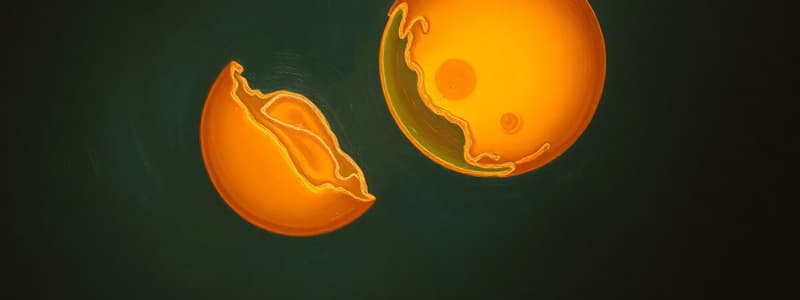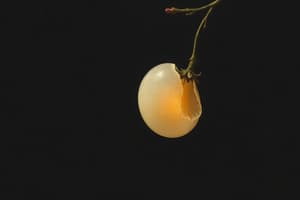Podcast
Questions and Answers
What is the primary characteristic of metallic lattices?
What is the primary characteristic of metallic lattices?
- They consist of dense, strong arrangements of atoms. (correct)
- They are only found in liquid metals.
- They are composed of molecules.
- They form gas-like structures.
Which of the following describes a unique property of metals in their lattice structures?
Which of the following describes a unique property of metals in their lattice structures?
- They remain solid at room temperature, except for one element. (correct)
- They can form volatile compounds.
- They can exist at any temperature.
- They are generally gaseous at room temperature.
What percentage of the elements are categorized as metals?
What percentage of the elements are categorized as metals?
- 50%
- 70%
- 80% (correct)
- 90%
Which of the following statements is true regarding the arrangement of atoms in metals?
Which of the following statements is true regarding the arrangement of atoms in metals?
What shape is the prostate gland typically described as?
What shape is the prostate gland typically described as?
Which of the following elements is an exception to the general state of metals at room temperature?
Which of the following elements is an exception to the general state of metals at room temperature?
What is one of the functions associated with the prostate gland?
What is one of the functions associated with the prostate gland?
Which of the following describes a consequence of prostate function?
Which of the following describes a consequence of prostate function?
The prostate gland surrounds which part of the male anatomy?
The prostate gland surrounds which part of the male anatomy?
What might be a physiological effect of prostate enlargement?
What might be a physiological effect of prostate enlargement?
What is the primary process described by deposition?
What is the primary process described by deposition?
Which of the following is NOT a force responsible for deposition?
Which of the following is NOT a force responsible for deposition?
In which scenario would deposition likely occur?
In which scenario would deposition likely occur?
How does deposition contribute to the formation of new landforms?
How does deposition contribute to the formation of new landforms?
What characteristic defines the materials involved in deposition?
What characteristic defines the materials involved in deposition?
Which non-metallic element is known to form crystal lattices?
Which non-metallic element is known to form crystal lattices?
What structure do carbon atoms form in graphite?
What structure do carbon atoms form in graphite?
Which of the following is NOT a form of carbon lattice?
Which of the following is NOT a form of carbon lattice?
How is the arrangement of atoms in diamond different from that in graphite?
How is the arrangement of atoms in diamond different from that in graphite?
Which property is primarily associated with the structure of graphite?
Which property is primarily associated with the structure of graphite?
What is one consequence of thermal expansion and contraction in materials?
What is one consequence of thermal expansion and contraction in materials?
Which process contributes to the widening of cracks in rocks during freeze-thaw cycles?
Which process contributes to the widening of cracks in rocks during freeze-thaw cycles?
How do plant roots contribute to the weathering of rocks?
How do plant roots contribute to the weathering of rocks?
What role does abrasion play in the weathering of rocks?
What role does abrasion play in the weathering of rocks?
Which environmental factor is least involved in the physical weathering process described?
Which environmental factor is least involved in the physical weathering process described?
What is the average length of the menstrual cycle in females?
What is the average length of the menstrual cycle in females?
Which of the following stages is NOT part of the menstrual cycle?
Which of the following stages is NOT part of the menstrual cycle?
During which stage of the menstrual cycle does the body prepare for a potential pregnancy?
During which stage of the menstrual cycle does the body prepare for a potential pregnancy?
What happens during the 'tear down' phase of the menstrual cycle?
What happens during the 'tear down' phase of the menstrual cycle?
What occurs if there is no fertilization during the menstrual cycle?
What occurs if there is no fertilization during the menstrual cycle?
Flashcards
Menstrual Cycle Stages
Menstrual Cycle Stages
The menstrual cycle is a roughly 28-day cycle with three main stages: tearing down, rebuilding, and preparing for potential pregnancy.
Menstrual Cycle Length
Menstrual Cycle Length
The average menstrual cycle lasts about 28 days.
Tear Down Stage
Tear Down Stage
The first stage of the menstrual cycle, where the uterine lining sheds.
Rebuild Stage
Rebuild Stage
Signup and view all the flashcards
Pregnancy Preparation
Pregnancy Preparation
Signup and view all the flashcards
Prostate Gland Function
Prostate Gland Function
Signup and view all the flashcards
Prostate Shape
Prostate Shape
Signup and view all the flashcards
Urethra's Surroundings
Urethra's Surroundings
Signup and view all the flashcards
Difficult Urination
Difficult Urination
Signup and view all the flashcards
Difficult Ejaculation
Difficult Ejaculation
Signup and view all the flashcards
Metallic elements
Metallic elements
Signup and view all the flashcards
Lattice structure
Lattice structure
Signup and view all the flashcards
Density of metals
Density of metals
Signup and view all the flashcards
Metal Strength
Metal Strength
Signup and view all the flashcards
Metal State at room temp.
Metal State at room temp.
Signup and view all the flashcards
Deposition
Deposition
Signup and view all the flashcards
What is deposition?
What is deposition?
Signup and view all the flashcards
What are the agents of deposition?
What are the agents of deposition?
Signup and view all the flashcards
How does deposition affect the landscape?
How does deposition affect the landscape?
Signup and view all the flashcards
Example of deposition
Example of deposition
Signup and view all the flashcards
Non-Metallic Lattices
Non-Metallic Lattices
Signup and view all the flashcards
Graphite Structure
Graphite Structure
Signup and view all the flashcards
Diamond Structure
Diamond Structure
Signup and view all the flashcards
Difference between Graphite and Diamond
Difference between Graphite and Diamond
Signup and view all the flashcards
Carbon's Versatility
Carbon's Versatility
Signup and view all the flashcards
Freeze-thaw cycles
Freeze-thaw cycles
Signup and view all the flashcards
How do freeze-thaw cycles break rocks?
How do freeze-thaw cycles break rocks?
Signup and view all the flashcards
Plant root weathering
Plant root weathering
Signup and view all the flashcards
Abrasion weathering
Abrasion weathering
Signup and view all the flashcards
What are the types of weathering?
What are the types of weathering?
Signup and view all the flashcards
Study Notes
Reproduction
- Reproduction is the process by which parents produce new individuals, called offspring.
- The two main methods of reproduction are sexual and asexual.
- Sexual reproduction typically requires two parents.
- Asexual reproduction means it only requires one parent.
- Sexual reproduction occurs when sperm from a male fertilizes an egg from a female.
- Sperm and eggs are called gametes.
- Fertilization results in a zygote.
- Some species have individuals with both male and female sex organs, called hermaphrodites (e.g., snails, fish).
- Cells normally reproduce by splitting into two identical cells, a process called mitosis.
- Sperm and eggs are formed by a different type of cell division called meiosis.
- Each gamete has half the genetic information of a normal cell.
- Fertilization combines the genetic material to form a complete set of instructions for the offspring.
- The fertilized cell (zygote) will divide repeatedly by mitosis to form a new individual.
Reproduction in Animals
- Males have testes that produce sperm.
- Sperm travel out of the body through a sperm duct.
- Females have ovaries that produce eggs.
- Eggs travel through oviducts.
- Internal fertilization occurs inside the female's body (e.g., mammals, some water animals).
- External fertilization occurs outside the female's body (e.g., most fish).
Comparing Reproductive Organisms: Flowers & Pollination
- The change in form and structure of an individual from zygote to adult.
- Development in animal life internally, where the young one remains in the mother's body until birth (e.g., cats, dogs...).
- Sexual reproduction in plants involves the formation of gametes in flowers.
- Pollen is produced in the anther and is transferred to the stigma (pollination).
- The pollen grain grows into a pollen tube that reaches the ovary.
- The male gamete joins the female gamete (in the ovule) and a seed develops.
Asexual Reproduction
- No joining of egg and sperm.
- The young grows from part of the parent's body or from an unfertilized egg.
- The offspring is a clone of the parent.
- Methods include budding, fission, and parthenogenesis.
Cloning
- The process of producing genetically identical individuals through reproduction.
- Involves asexual reproduction.
- Examples include plant cloning (tissue culture, cuttings)
- Clones are produced from a single parent.
Cloning in Agriculture
- Used to copy plants with desirable characteristics.
- Produces a crop of identical plants.
Cloning Plants
- Involves taking small sections from a desirable plant.
- Growing these sections into complete new plants.
Plant Tissue Culture
- A laboratory method of cloning plants.
- Inexpensive but widely used.
Cell Tissue Culture
- Cloning individual cells instead of plant parts.
- Plants may differ from parent plant due to cell division.
- Used for propagation of desired characteristics in plants.
Roles of human reproductive systems
- The role of the female reproductive system is to produce a baby.
- The role of the male reproductive system is to produce and deliver sperm.
- The main female reproductive structures are: Ovaries, fallopian tubes (oviducts), uterus, cervix, and vagina.
- The main male reproductive structures are Testes, Epididymis, Vas Deferens (Sperm Duct), Seminal Vesicles, Urethra, Prostate Gland.
Development
- Ovulation is when mature eggs are released into fallopian tubes.
- Fertilization occurs in the fallopian tubes.
- The zygote develops into an embryo, then a fetus.
- The fetus develops in the uterus until birth.
- The cervix opens to allow the baby to exit through the vagina.
Substances and Change
- Everything consists of small building blocks called atoms.
- Only about 100 different types of atoms exist.
- Chemical reactions involve reorganizing atoms and form new substances.
The Atom
- Atoms consist of neutrons, protons, and electrons.
- Protons and neutrons are in the nucleus and carry a + charge or no charge.
- Electrons surround the nucleus, and carry a negative charge.
Elements
- An element is a substance that is formed by a single type of atom.
- Elements have their own set of unique characteristics and properties.
Periodic Table
- 118 known elements are arranged in a table.
- Elements are ordered based on their properties and atomic structure.
- Elements in the same column (group) have similar properties.
- Elements in the same row (period) have similar properties.
Chemical Symbols
- Abbreviations for the name of each element.
- A shorthand way to write the elements.
- Sometimes chemical symbol doesn't relate to its name (e.g. Potassium is K)
Atoms in Elements
- Atoms in elements can exist as single atoms, in clusters (molecules).
- Or in large grid-like structures (crystal lattices)
- Arrangement of atoms within an element determines the element's properties (e.g., its state of matter at room temp, ability to conduct electricity, reaction with other substances).
Molecular Formulas
- Representations of molecules composed of atoms.
- Subscripts denote the number of each type of atom in the molecule.
Chemical and Physical Change
- Physical change alters a substance's appearance without changing its chemical identity. (Example Cutting paper in half)
- Chemical changes involve altering the chemical composition (Example burning wood into ashes)
Terms for Change
- Definitions for different types of changes (e.g., Melting, Freezing, Condensation)
- Chemical equations are a shorthand way to represent chemical reactions.
- Reactants are the substances that undergo the reaction.
- Products are the substances formed in the reaction.
Energy
- Energy exists in many different forms (kinetic, potential, sound, light, electrical).
- Kinetic energy is the energy of motion, and potential energy is stored energy.
- Energy can be transferred between objects.
Energy Transfer
- Energy is transferred when there is a change in state of matter.
- Energy is transferred between objects as heat.
- Heat transfer can happen through conduction, convection or radiation.
- Conduction happens when heat energy is transferred through direct contact (e.g., touching a hot pan).
- Convection happens when heat energy is transferred by the movement of fluids (e.g., warm air rising).
- Radiation happens when heat energy is transferred through space (e.g., feeling the heat of the sun).
Sound Energy
- Sound is produced by vibrations.
- Sound travels as waves through the air (or other medium).
- The speed of sound depends on the material the sound travels through.
- The properties of sound are characterized by pitch, frequency, wavelength, and loudness.
Light Energy
- Light Energy travels as waves that do not need a medium to travel.
- Light is a form of electromagnetic radiation.
- Light energy is characterized by the wave properties of frequency and wavelength. The colour of light is determined by its wavelength.
Geology
- Geology is the science of the Earth's physical structure and substances.
- Scientists study the layers of the Earth and their composition.
- Scientists study rocks and their formation.
Studying That Suits You
Use AI to generate personalized quizzes and flashcards to suit your learning preferences.





